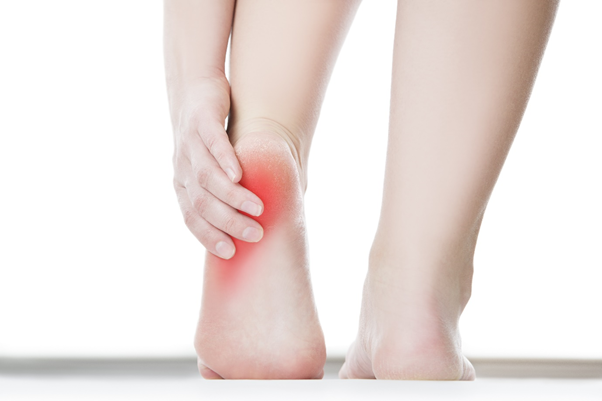Plantar Fasciitis

What is plantar fasciitis?
Plantar fasciitis is the most common disorder of the foot affecting the heel and underside of the foot and will affect 10% of the population sometime in their life. That’s right, 1 in 10 people will suffer from this condition which can range from a little flare up to a chronic issue lasting for years! It is characterised by heel pain and pain in your plantar fascia—a strong and dense connective tissue structure on the sole of your foot that supports your foot arch. Chances are you or someone you know have had plantar fasciitis, particularly if you are reading this!
Your plantar fascia ligament is imperative to your feet as it helps the bones of your foot absorb the stresses of standing, walking and running and commonly it is most painful at the point where your plantar fascia attaches to your calcaneus, or heel bone. By pressing into the inner part of your heel you will commonly feel a sharp, bruising pain.
The universal characteristic of plantar fasciitis is to experience pain during the first few steps out of bed in the morning in the heel which improves as the foot warms up. X-rays can be used as a diagnostic imaging technique to evaluate the possibility of a bone spur as an indication of your heel pain. A bone spur, if it is present in this location, is probably not the cause of your pain, but it is evidence that your plantar fascia has been exerting excessive force on your heel bone and developed calcification in the area.
Causes of plantar fasciitis
A number of factors can contribute to plantar fasciitis but you’re more likely to develop plantar fasciitis if you:
- Are overweight.
- Are aged between 40-60 years old.
- Take up a new form of exercise or rapidly increase the intensity of your exercise.
- Have a job where you are on your feet for several hours each day.
- Have other underlying medical conditions such as rheumatoid arthritis, psoriasis or lupus which can cause heel pain in themselves.
- Wear high-heeled shoes for long periods.
- Wear shoes that have weak arch supports and thin soles.
- Have flat feet or high arched feet.
- Have leg length differences or an abnormal gait cycle.
- Have calf muscle shortening/tightness
- Have plantar fascia contracture
Plantar fasciitis vs plantar fasciosis – what is the difference?
This condition has historically been called plantar fasciitis because it was believed that plantar fascia inflammation was the principle underlying cause, however this is not the case. In very acute cases it can be just inflamed and painful but in most cases plantar fasciosis is a more accurate name for this condition because it involves facial degeneration, microtears and thickening, not specifically inflammation.
You might be wondering why it is even important to categorise the injury? This is because the treatment for each level of injury is very different and it can be broken down into the following phases:
Phase 1: Acute plantar fasciitis (1-4 weeks)
Pain in the heel or arch that normally develops after a run or an event. Pain normally resolves quickly with rest and conservative measures.
Phase 2: Moderate plantar fasciitis (4-12 weeks)
Pain has become persistent and regular and although the pain isn’t there all day, it is present in the morning and with high impact activity.
Plantar fasciosis (12+ weeks)
Pain has worsened and is now affecting your lifestyle, you can’t participate in your gym or sport and you have high level pain which isn’t responding to basic treatments. You are starting to get worried this might not resolve.
Severe plantar fasciosis (12+ weeks with trouble walking or standing)
At this stage you are having consistent, high level pain all day and it is driving you mad! You have tried a number of treatment options and they have all failed and you are losing faith, you are almost resigned to giving up on exercising again due to the pain. This is what we thrive on at CHPI, we can help you as we have treatment plans to get you short term and long term pain relief.
Treatment for plantar fasciitis
The art of treating plantar fasciitis or plantar fasciosis is determining the causing factor(s) and correcting them, it is all too common that plantar fasciitis is treated with a standard plan which works for some but not for others.
Often a combination of treatment options is required to address multiple influences and when the right treatments are put in place good clinical outcomes happen! At CHPI we assess and determine what is influencing your pain and accurately treat so you know that you aren’t incorporating too many treatments or even worse, not enough! Our ultimate goal is to reduce your pain and get you back to activity.
Conservative treatments such as ensuring you have the correct shoes, adequate strength and flexibility and certain taping techniques are great to provide short term pain relief. For more persistent cases orthotics to relieve the stress and micro-tears through the ligament combined with night splints, injections and shock wave are all successful treatments – check them out in detail on our treatment options page!
About 90 percent of people with plantar fasciitis improve significantly after two months of initial treatment, however, if you don’t treat plantar fasciitis it may become a chronic condition. You may not be able to keep up your level of activity, and you may develop compensatory symptoms of the foot, knee, hip and back problems because of your altered gait pattern. Get fixed up once and for all today!
